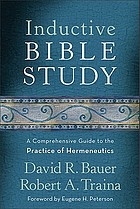I. Observation
A. Survey the book-as-a-whole- Identify the general materials of the book (biographical, ideological, historical, geographical, chronological).
- Locate the major units and subunits in the book and identify the main structural relationships operative in the book-as-a-whole.
- Ask a few interpretative questions based on each major structural relationship observed.
- Identify the key verses and strategic areas that provide insight into the book-as-a-whole.
- Identify higher-critical data.
- Note other major impressions relating to the book-as-a-whole.
- Locate the major units and subunits within the section or segment and the main structural relationships operative in the section or segment-as-a-whole.
- Ask a few interpretative questions based on each major structural relationship observed.
- Identify the key verses and strategic areas that provide insight into the section or segment-as-a-whole.
- Identify the literary form(s) employed in the section or segment.
- Identify other major impressions.
II. Interpretation
A. Answer the most significant questions raised in the observation of paragraphs and verses- Identify the most significant questions asked based on importance, difficulty and interests.
- Note the types of evidence available for answering each interpretive question and employ this evidence to answer each question selected.
III. Evaluation and Appropriation
A. Find the truths or principles that can legitimately be applied to contemporary times and places other than the original scriptural settings.B. Relate these truths or principles to appropriate contemporary situations so as to inform your response to the contemporary issue or problem.
IV. Correlation
A. Relate the book's theology to the teaching of other biblical materials by the same author.B. Relate the book's theology to the New Testament-as-a-whole (or to the Old Testament-as-a-whole).
C. Relate the book's theology to the Bible-as-a-whole, thus developing a biblical theology.
From Bauer, David R, and Robert A Traina. Inductive Bible Study: A Comprehensive Guide to the Practice of Hermeneutics. Grand Rapids, MI: Baker Academic, 2011, pp.73-74.

Комментариев нет:
Отправить комментарий